Hybrid Project Management: The Ultimate Guide to Blending Agile and Waterfall Methodologies
The current dynamics of business need something that traditional project management methodologies often fail to deliver. What’s needed is something that has a standardized approach, results, and is flexible.
Project execution should have a blend of flexible yet structured approach, Hybrid project management is one such strategic blend of traditional Waterfall and Agile methodologies.
This article will equip you to:
- The fundamental principles of hybrid project management
- How to effectively blend traditional and agile methodologies
- Real-world applications and success stories
- Practical implementation strategies I’ve developed through years of consulting
What are Traditional Project Management Methodologies?
Let’s take a look at traditional project management methodologies and build our base to better understand hybrid approaches and why they are needed.
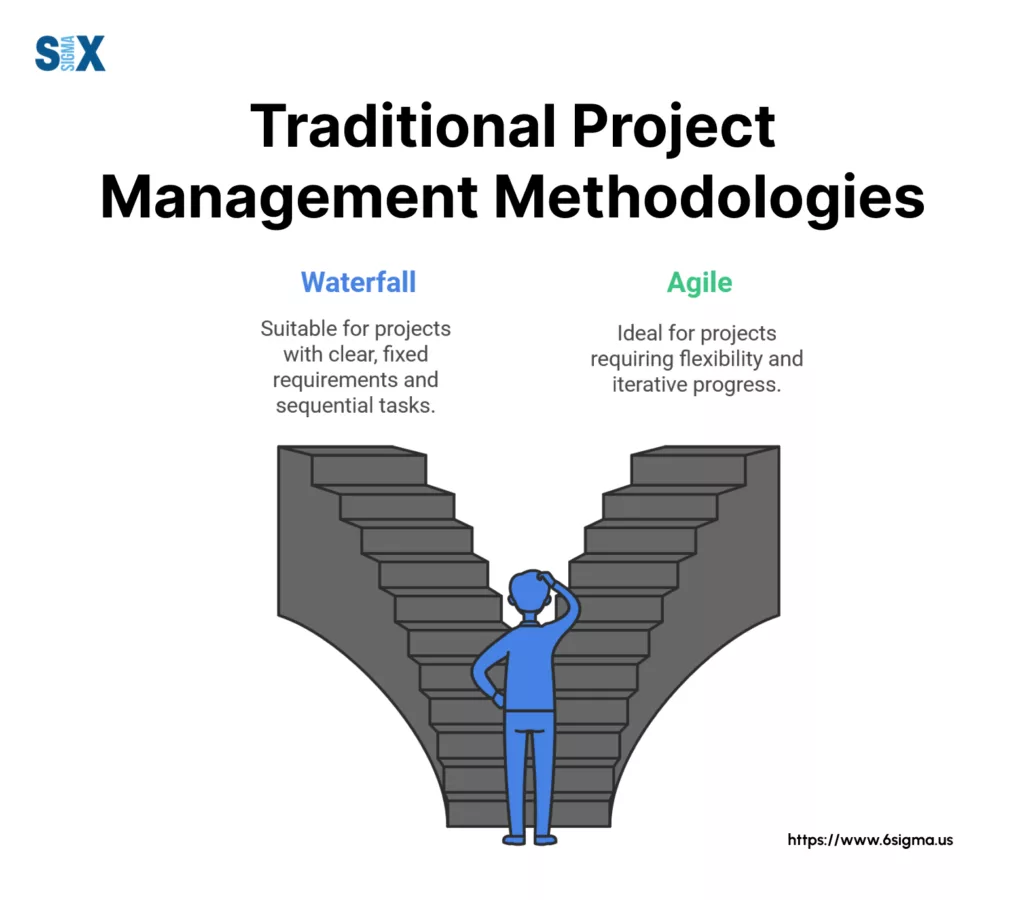
Waterfall Methodology
The Waterfall methodology is a sequential, linear approach to project management. It works like a series of events – each phase must be completed before moving to the next.
Key characteristics include:
- Detailed upfront planning
- Sequential phase progression
- Comprehensive documentation
- Clear stage gates and milestones
Waterfall’s advantages:
- Clear structure and predictability
- Excellent for projects with fixed requirements
- Strong documentation and compliance tracking
- Easy to understand and manage
Waterfall’s limitations:
- Rigid and resistant to change
- Late-stage changes are costly
- Delayed value delivery
- Limited stakeholder feedback
Agile Methodology
Agile embraces change and focuses on iterative development. Agile methodology addressed many of Waterfall’s limitations.
Core principles include:
- Iterative development cycles
- Continuous feedback
- Self-organizing teams
- Adaptive planning
Agile’s advantages:
- Faster value delivery
- Better adaptation to change
- Increased stakeholder engagement
- Continuous improvement
Agile’s limitations:
- Less predictable outcomes
- Requires experienced teams
- Can be difficult to scale
- May lack detailed documentation
The Gap and Emergence of Hybrid Approaches
During my consulting work, I noticed a consistent pattern: neither methodology fully satisfied complex project requirements. For instance, while working with a major telecommunications company, we needed Waterfall‘s hardware development structure but Agile‘s software components flexibility.
This gap led to the creation of hybrid approaches. They combine the best of both worlds – Waterfall’s structured planning with Agile’s adaptability.
What is Hybrid Project Management?
It is a strategic blend of traditional Waterfall and Agile methodologies to create a flexible yet structured framework and drive successful project execution.
It’s not simply a mix of methodologies, but rather thoughtfully selecting and integrating the most effective elements of each approach to meet specific project needs.
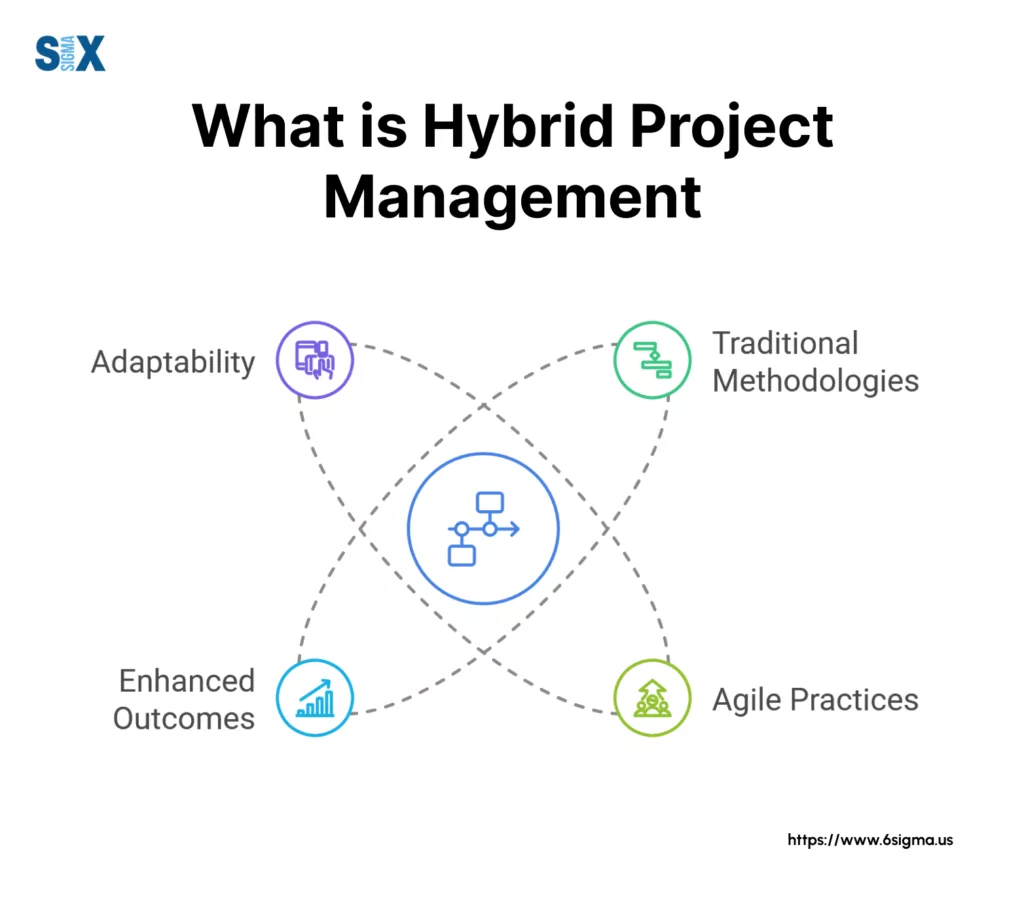
The key characteristics of hybrid project management include:
- The ability to maintain structured planning while accommodating change
- Integration of both sequential and iterative processes
- Flexible documentation requirements based on project needs
- Balanced stakeholder involvement throughout the project lifecycle
A key characteristic of hybrid project management that I’ve found particularly valuable is its adaptability to different organizational contexts. I’ve seen how hybrid approaches can be tailored to meet strict documentation requirements while still maintaining agile elements for rapid response capabilities.
Keep in mind that Waterfall isn’t Agile or hybrid – it’s one of the foundational methodologies that can be strategically combined with Agile principles to create a hybrid approach.
The hybrid approach creates a framework that’s both robust and flexible. It allows organizations to maintain the structure needed for compliance and predictability while incorporating adaptability.
Struggling with Recurring Project Management Issues? Master the Art of Problem-solving with Root Cause Analysis Training
Learn a structured approach to identify and eliminate the root causes of your project challenges. Perfect for teams transitioning to hybrid methodologies who need to solve complex implementation problems.
Benefits of Hybrid Project Management
Let’s look at how hybrid project management transforms project delivery effectiveness.
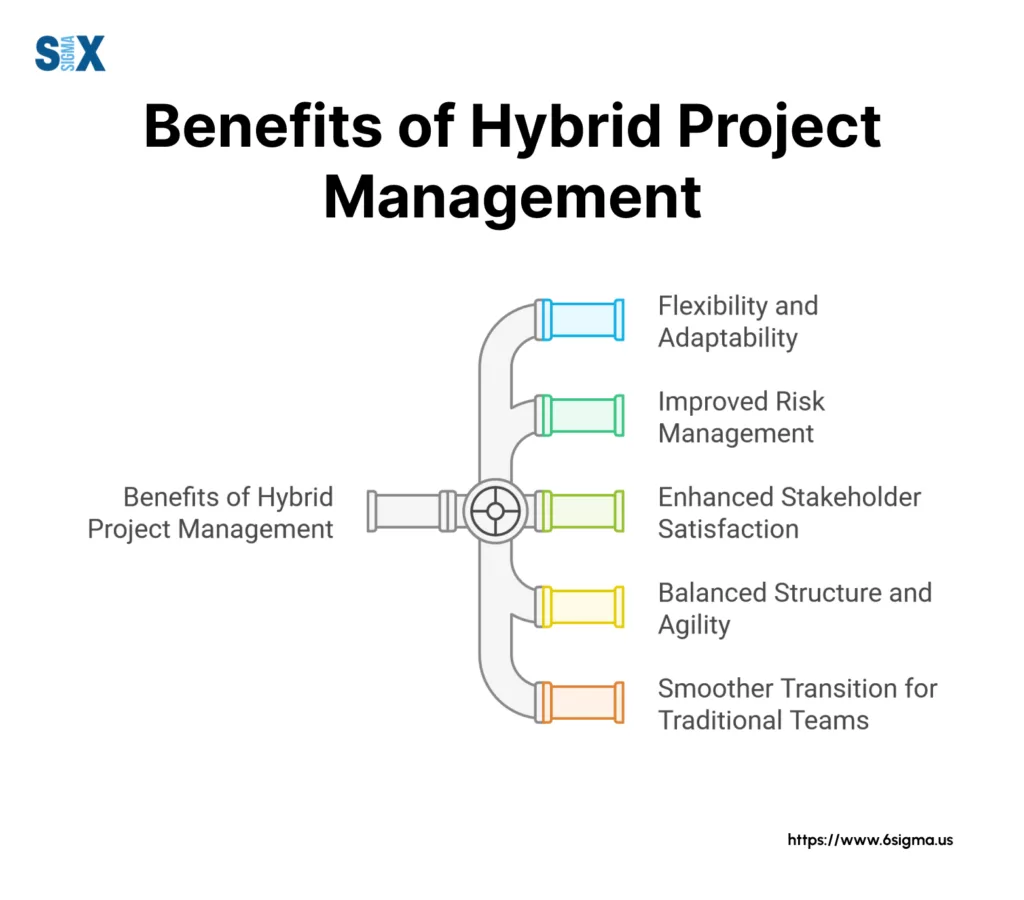
Flexibility and Adaptability
Hybrid project management provides unprecedented flexibility. For instance, when working with a major semiconductor manufacturer, we maintained rigid quality control processes while allowing for rapid design iterations.
This hybrid approach project management strategy enabled the team to respond to market changes without compromising quality standards.
Improved Risk Management
One of the most significant advantages I’ve documented through my consulting work is enhanced risk management. By combining Waterfall’s thorough planning with Agile’s iterative approach, organizations can identify and mitigate risks more effectively.
I recall a particular project where this hybrid approach helped us catch potential issues early in the development cycle, saving millions in potential rework costs.
Enhanced Stakeholder Satisfaction
Throughout my international consulting experience, I’ve consistently observed higher stakeholder satisfaction with hybrid approaches. The regular feedback loops of Agile, combined with the clear milestone structure of Waterfall, keep stakeholders engaged and informed.
During a project with a government institution, this balanced approach resulted in a 40% increase in stakeholder satisfaction scores.
Balanced Structure and Agility
The project management hybrid approach provides what I call the “golden mean” of project execution. While leading Six Sigma deployments, I’ve helped organizations maintain necessary governance structures while enabling quick responses to changing requirements.
This balance is particularly crucial in regulated industries where compliance is non-negotiable but innovation is essential.
Smoother Transition for Traditional Teams
One benefit that often goes unmentioned is the easier adoption curve. Using a hybrid approach allowed teams to gradually adapt to new ways of working without disrupting ongoing projects. This measured transition resulted in higher team engagement and better project outcomes.
Why choose hybrid project management?
The answer lies in its unique ability to combine the best of both worlds. Organizations can maintain the structure needed for governance and compliance while gaining the agility required in today’s fast-paced business environment.
I’ve seen this approach reduce project delivery times by up to 30% while improving quality metrics across the board.
Challenges in Implementing Hybrid Project Management
The most immediate challenge I encounter as a hybrid project manager is resistance to change. I observed how deeply ingrained traditional methodologies can become in organizational culture.
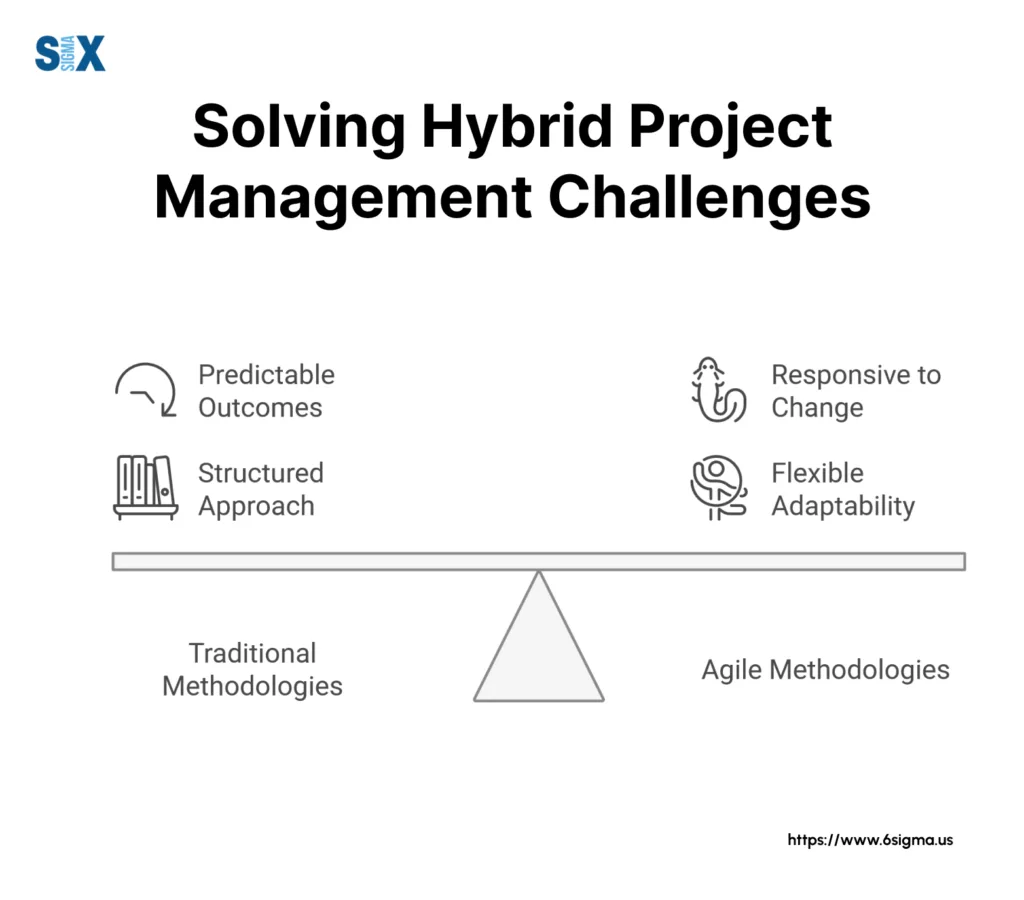
For instance, when implementing a hybrid approach in a manufacturing division, seasoned project managers initially resisted adopting Agile elements, viewing them as incompatible with their established processes. We overcame this by implementing gradual changes and demonstrating tangible benefits through pilot projects.
Complexity in planning and execution presents another significant hurdle. I’ve seen how combining methodologies can create confusion if not properly structured. During an implementation at a technology firm, we had to carefully balance Waterfall’s rigid planning requirements with Agile’s flexibility.
The solution involved creating a clear delineation between phases that required strict sequential execution and those that could benefit from iterative development.
The potential for miscommunication becomes amplified in hybrid environments. While consulting for government institutions, I’ve noticed how different stakeholders often speak different “methodological languages.”
A hybrid approach in project management requires establishing clear communication protocols that bridge these differences. I typically recommend creating standardized reporting templates that satisfy both traditional milestone-based tracking and Agile progress metrics.
Balancing conflicting methodologies perhaps presents the most nuanced challenge. For example, maintaining regulatory compliance while implementing rapid development cycles. The solution would involve creating a framework that preserved necessary documentation and approval processes while allowing for agile development within those boundaries.
To address these challenges effectively, I recommend:
- Developing a comprehensive change management strategy
- Creating clear governance structures
- Establishing robust communication frameworks
- Implementing flexible resource allocation systems
- Providing thorough training in both methodologies
Learn the Balance between Structure and Agility in Your Organization
Learn how to analyze value streams and tie projects to strategic initiatives with our Lean Six Sigma Organizational Deployment and lead successful hybrid implementations.
Implementing Hybrid Project Management: A Step-by-Step Guide
Here’s a comprehensive approach to implementing hybrid methodology in project management. Let me walk you through the essential steps.
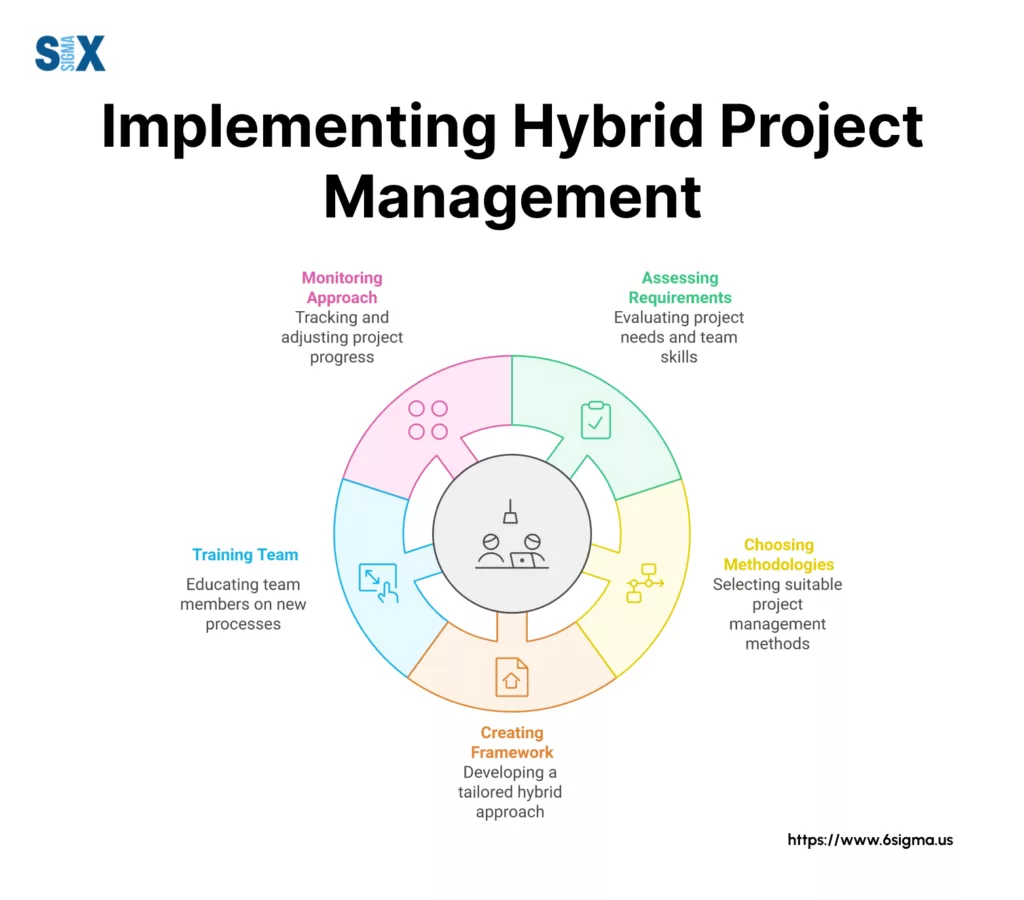
Assessing Project Requirements and Team Capabilities
Conduct a thorough assessment by evaluating:
- Project complexity and scope
- Regulatory requirements
- Team experience with different methodologies
- Organizational culture and readiness for change
- Available resources and technology infrastructure
Choosing Elements from Different Methodologies
Successful hybrid implementations require a careful selection of methodology components:
- Identified which phases needed rigid structure (compliance documentation)
- Determined areas suitable for agile approaches (development cycles)
- Mapped dependencies between different project components
- Evaluated risk factors for each chosen element
Creating a Customized Hybrid Framework
Creating a tailored framework is crucial. Your hybrid project management framework should:
- Define clear governance structures
- Establish communication protocols
- Set up reporting mechanisms that satisfy all stakeholders
- Create flexible yet structured project timelines
- Include risk management procedures
Training and Onboarding Team Members
A comprehensive training approach that includes:
- Initial methodology overview sessions
- Hands-on workshops with real project scenarios
- Role-specific training modules
- Mentoring programs for key team members
- Regular refresher sessions
Monitoring and Adjusting the Approach
I recommend implementing:
- Regular performance metrics reviews
- Feedback collection mechanisms
- Sprint retrospectives (for agile components)
- Milestone reviews (for waterfall elements)
- Continuous improvement protocols
Throughout the implementation process, it’s crucial to maintain flexibility and be ready to adjust your approach.
For example, during a project, we initially planned for a 70-30 split between traditional and agile methods, but based on early results, we adjusted to a 50-50 balance that better suited the client’s needs.
Transform your Project Management Approach with Confidence.
Our Define Phase and Project Selection training provides the foundation for successful project planning and execution, with modern tools and techniques for both traditional and agile methodologies.
Industry-Specific Applications of Hybrid Project Management
Hybrid agile methodology adapts to different sector-specific needs. Let’s look at some examples of how organizations tailor hybrid approaches to their unique requirements.
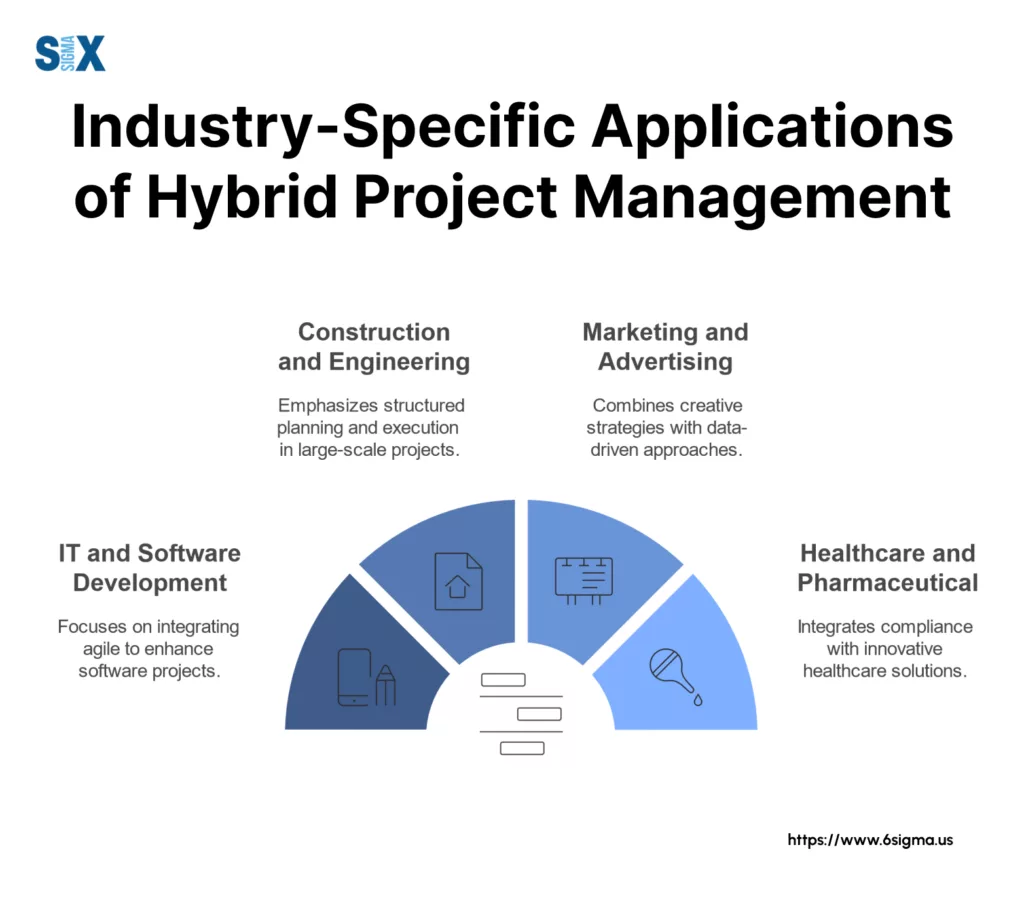
IT and Software Development
Hybrid project management excels in software development. In one notable implementation, we created a framework that:
- Used Waterfall for infrastructure and security requirements
- Implemented Agile sprints for feature development
- Maintained compliance through structured documentation
- Enabled rapid deployment through continuous integration
The result was a 40% reduction in time-to-market while maintaining rigorous quality standards.
Construction and Engineering
Hybrid approaches can significantly improve project outcomes. While working with a major manufacturing facility, we:
- Applied traditional planning for regulatory compliance and safety protocols
- Utilized Agile principles for equipment installation and testing
- Implemented rolling wave planning for resource allocation
- Created flexible response mechanisms for weather-related delays
This approach reduced project completion time by 25% compared to traditional methods.
Marketing and Advertising
During my work with marketing teams at various organizations, hybrid methodologies balance creativity with structure. A campaign implementation featured:
- Waterfall planning for budget and resource allocation
- Agile sprints for content creation and testing
- Real-time feedback loops for market response
- Structured reporting for stakeholder communications
Healthcare and Pharmaceutical
My experience in the healthcare sector, particularly during regulatory compliance projects, has demonstrated the value of hybrid approaches. Working with a major pharmaceutical company, we:
- Maintained strict Waterfall processes for compliance documentation
- Implemented Agile methodologies for research and development phases
- Created hybrid reporting systems for stakeholder management
- Developed flexible quality control processes
This balanced approach resulted in faster product development while maintaining perfect compliance records.
Key Industry-Specific Considerations:
- Regulatory requirements and compliance needs
- Project complexity and scale
- Team distribution and collaboration requirements
- Stakeholder expectations and reporting needs
- Industry-specific risk factors
Key Insights I Learned from Applying Hybrid Project Management
I’ve gained valuable insights into what makes hybrid methodologies succeed or fail. Let me share some key learnings from my journey as a Master Black Belt and consultant.
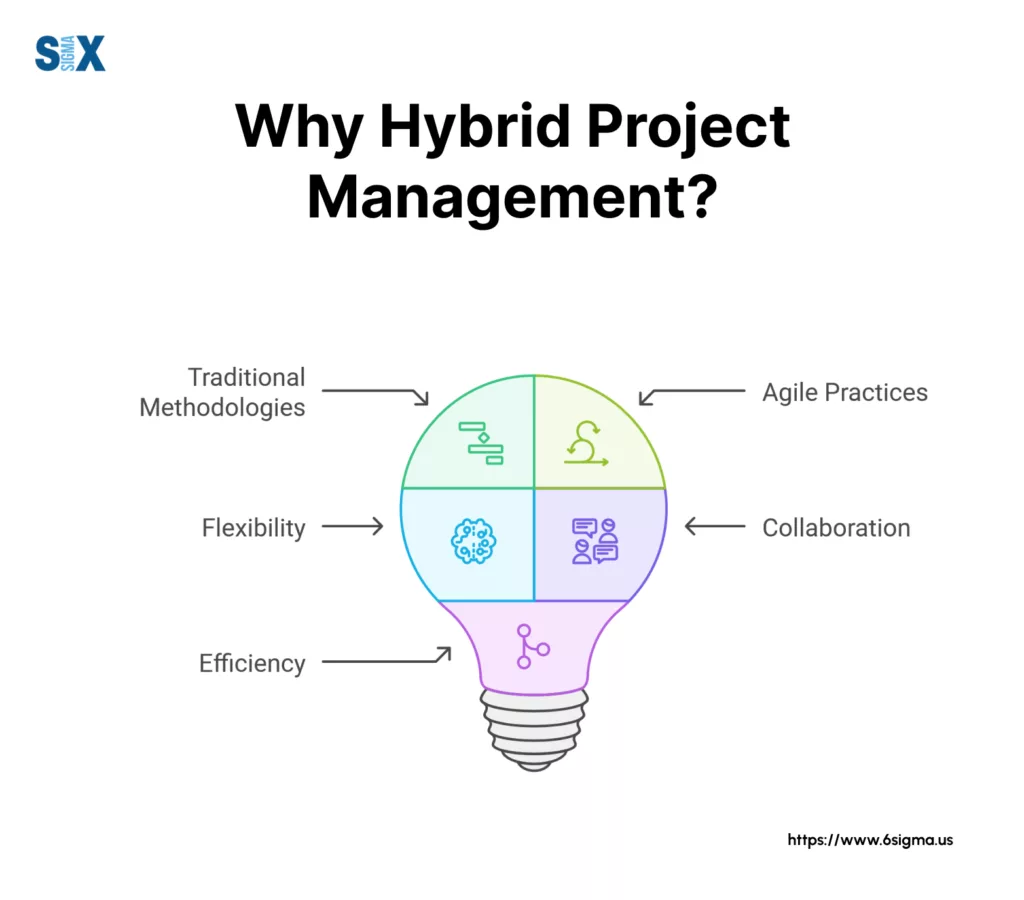
Common Challenges and Solutions
The biggest challenge I see is resistance to change, teams often struggle with letting go of familiar methodologies.
At an implementation for a major technology firm, we overcame this by creating a transition roadmap that gradually introduced hybrid elements while maintaining familiar workflows. This approach resulted in 90% team adoption within three months.
Tips for Successful Implementation
First, focus on building a strong foundation. We discovered that comprehensive training and clear communication channels were crucial. Start with pilot projects to demonstrate value, then scale gradually.
I also emphasize the importance of customization: “Don’t try to force-fit a generic hybrid framework. When I worked with a pharmaceutical company implementing their hybrid approach, we carefully analyzed their specific needs and regulatory requirements before designing their framework.”
Future Outlook for Hybrid Methodologies
Hybrid project management is evolving rapidly. We’re seeing increased integration of artificial intelligence for project planning and risk assessment.
During an implementation at a healthcare organization, we successfully incorporated AI-driven analytics to optimize resource allocation across both Waterfall and Agile components.
Best Practices from the Field:
- Always start with a thorough assessment of your organization’s readiness.
- Invest in proper training and change management.
- Create clear communication protocols that bridge traditional and agile approaches.
- Implement robust feedback mechanisms for continuous improvement.
- Maintain flexibility in your framework to adapt to changing needs.
“The future of hybrid project management lies in its adaptability. Organizations that can effectively blend structure with agility while maintaining focus on continuous improvement will see the greatest success.”
SixSigma.us offers both Live Virtual classes as well as Online Self-Paced training. Most option includes access to the same great Master Black Belt instructors that teach our World Class in-person sessions. Sign-up today!
Virtual Classroom Training Programs Self-Paced Online Training Programs







